A 6-year-old boy was infected with a rare "brain-eating worm" while swimming at the beach! There is currently no specific medicine, and the mortality rate is as high as over 90%!

|
"My original intention was to take my child to see the world, to know the sea, to relax and have fun, but as a mother, I have to live in regret and self-blame forever..." On June 26, a mother named "Miaomiao" shared her sad experience online: In early June, she took her five- or six-year-old son Cheng Cheng (pseudonym) to Haikou for a trip. Just swimming at the beach, he was infected with the rare "amoeba". The most terrible thing is that there is currently no specific medicine for this disease, and the mortality rate is extremely high. The kind-hearted mother Cheng Cheng said in the message that she originally did not want to post these experiences online, but thinking that this disease is so dangerous, she did not want to see other children suffer from it, so she still posted her experience to remind more mothers to pay attention. After swimming at the beach, I had a high fever Infected with "brain-eating worm" In early June, Cheng Cheng's mother and family took their son to Haikou for a trip. Two days after they came back (June 9), the child began to have a fever of 39°C. The next day, they went to a local hospital for treatment. They thought it was tonsillitis and took antipyretics. On June 11, the fever was still high. On June 12, Cheng Cheng's mother took him to the local hospital for examination again. The liver function and other indicators were normal. There was bronchitis in the lungs. Then he was hung with saline for 2 days, but the fever did not go down. On June 14, Cheng Cheng had a blood routine test at the local Maternal and Child Health Hospital. Infections such as EB virus infection and mycoplasma pneumonia were ruled out, but the cause was still not found. Because the high fever did not subside, he was transferred to a higher-level hospital on June 15. At this time, Cheng Cheng's condition was more serious, with headaches, drowsiness, and severe vomiting symptoms. He vomited whatever he ate. Later, his blood pressure and body temperature continued to drop, and he soon became unconscious and fell into a coma. He was admitted to the intensive care unit (ICU) on June 19. On June 21, the doctor told Cheng Cheng's mother that according to the CT scan results that morning, the child's intracranial pressure was very high and brain tissue was severely damaged, and he might have to face a craniotomy. However, the assessment found that the child was in poor condition, his blood pressure was very unstable, and the operation was very risky. Cheng Cheng's condition deteriorated very quickly. Surgery was not feasible and conservative treatment was not effective. Even if he survived the surgery, an examination found an unknown turbid foreign body at the back of his brain. At that time, it was analyzed that it might be a tumor or brain tissue necrosis, so the only thing he could do was to extract cerebrospinal fluid for testing. On June 25, Cheng Cheng's cerebrospinal fluid test results came out. What no one expected was that the child was infected with "amoeba", also known as "brain-eating worm". The most terrible thing is that there is currently no specific medicine for this disease in China, and the mortality rate is as high as over 90%. Cheng Cheng's mother thought about it carefully and found that there seemed to be some signs before the child had a fever. Two days before the fever, the child complained of a headache at the back of his head. She thought that he was sunburned after returning from a trip to Haikou, so she didn't pay attention. Two days later, the child suddenly had a fever for no apparent reason. At this time, something might have gone wrong. "I really recalled it countless times, and I really felt that the most likely cause was swimming. The child did not eat seafood or raw food." Cheng Cheng's mother said that she did not want to write about these painful experiences, but she also wanted other mothers to be alert to this "amoeba" and carefully protect their children's growth. There are two ways for amoeba to enter the human body What is amoeba infection? Is it really a "brain-eating worm"? Huang Lisu, chief physician and director of the Department of Infectious Diseases at Zhejiang University Children's Hospital, said that amoeba is a rare parasite that lives in tropical and subtropical areas, mostly in water, soil, and decaying organic matter. According to relevant reports, there are only about 200 cases of infection worldwide, and only dozens of cases in China. Amoeba infection is mainly divided into skin infection and cranial and brain infection. Generally speaking, amoeba has two ways to enter the human body. One is through agricultural work, often some farmers. Parasites enter the human body through the skin. Generally, after infection, skin erythema will appear and it is difficult to cure. Amoeba is often found through skin biopsy. If it takes a long time, once the parasite infects the brain tissue, the subsequent cure rate will be relatively poor. Another is when people swim in rivers, lakes, or ponds or wash their noses with water infected with brain-eating worms, they drill into the human brain from the nasal cavity and multiply rapidly, causing suppurative meningoencephalitis, vascular hemorrhage, and brain parenchyma necrosis. Primary amoebic meningoencephalitis develops rapidly and progresses rapidly. Symptoms include headache, fever, vomiting, etc., and quickly turn into paralysis and coma, and death can occur within a week. Therefore, abroad, amoeba has the notoriety of "brain-eating worms". Hangzhou boy infected with amoeba After 2 months of treatment, he was out of danger At the beginning of this year, the Department of Infectious Diseases at Zhejiang University Children's Hospital admitted a child with amoeba infection, a boy in the third or fourth grade of elementary school. Director Huang introduced that the boy's name was Xiao Wei (pseudonym). Last summer vacation, he went to the river to swim while playing in the surrounding areas of Hangzhou. He may have choked during the swimming process. Not long after returning, he felt a little headache. At that time, he went to the hospital for a head CT scan, but nothing abnormal was found. Until the beginning of this year, Xiao Wei suddenly developed symptoms such as convulsions, headaches, and fever. He went to the hospital for a magnetic resonance imaging of the head, and found a large mass of something like a granuloma in the skull, about four or five centimeters in diameter. "At first we suspected that it might be a tumor, so we performed surgery to remove it, and pathological examination ruled out the possibility of a tumor. But after the operation, the child's condition still did not improve, and the site of the intracranial lesion became larger again. Through gene sequencing and related tests, we finally confirmed that it was an amoeba infection." Director Huang Lisu said that brain infection caused by amoeba is very rare, but once infected, the mortality rate is as high as over 90%. According to the US Centers for Disease Control and Prevention, 154 cases of infection were reported in the United States between 1962 and 2021, and only four people survived. Especially after children are infected, there are even fewer precedents for successful treatment internationally. What's more tricky is that most of the current international treatment drugs for amoeba infection are for adults, and there are few treatments specifically for children's intracranial infections. At that time, Director Huang held several MDT discussions with experts from many domestic children's hospitals and experts from well-known foreign children's hospitals. In combination with a large number of domestic and foreign medical literature, they discussed individualized medication treatment plans for Xiao Wei's condition. Fortunately, the treatment plan was very effective for Xiao Wei. After about 2 months of treatment, he finally got better and was out of danger. After being discharged from the hospital, he returned to school to continue his studies and life. Don't let your children swim in unclean water It is recommended to wear a nose clip when swimming Summer vacation is here, and many parents will take their children to the beach or go swimming. In this regard, Huang Lisu said that although infection with amoeba is a low-probability event, parents should still pay attention and try not to swim in unclean rivers. In addition to amoeba, unclean water may also contain parasites such as Sparganum mansoni and nematodes. When people swim in the water, they will inevitably choke on water. At this time, parasites may enter the human body through the nasal cavity. By wearing a nose clip or keeping the head above the water, the amount of water entering the nose can be limited. In addition, eating undercooked snake or frog meat may also cause parasitic infection. Especially when cooking frogs or snakes, sometimes they may look cooked on the outside, but in fact they may not be cooked through inside. If you eat half-cooked snakes or frogs, you may be infected with sparganosis. Director Huang reminds parents to pay attention. If you suspect your child has been infected with parasites, such as anal itching, white spots on the teeth or skin, unexplained high fever, etc., you must seek medical attention in time. If the eosinophil level is elevated during the physical examination, or spots are found during the liver examination, it must be taken seriously and it is recommended to see a specialist. Metropolis Express·Chengshi Interactive reporter Yu Qianqian and correspondent Zhu Yaoling |
>>: Air quality actually affects box office? !
Recommend
Shaoxing Real Estate Mini Program investment price inquiry, how much is the Shaoxing Real Estate Mini Program investment price?
How much does it cost to attract investment for S...
It is obviously a close relative of the cow, so why does it look so much like a deer?
Audit expert: Chen Yu Paleontological restoration...
Don’t know how to do community operations? Try these 5 ideas for user operations
Community operation has been very popular recentl...
DXOMARK overturned a large-scale double standard scene: mistook the screen protector for OLED screen burn-in, and gave the same screen two ratings
Recently, former OPPO vice president Shen Yiren c...
Why is space still pitch black even though the universe is filled with stars?
1. Why is the night sky of Earth never illuminate...
The "dark mode" you see in iOS 13 is actually not eye protection
The bright white background is gradually being re...
How good are the Chinese at planting trees?
The reporter learned from the National Forestry a...
What are the things to pay attention to when publishing works on Douyin? A graphic tutorial on how to publish your works on Douyin with notes
Publishing your works on Douyin may make you famo...
"What you found is a football!"
Written by Liu Dun One day in September 1985, Har...
Unintelligent "smart drugs", back off! Back off! Back off!
"Take one pill before the exam, and you'...
6 core concepts of community operation!
I recently reread Professor Xu Zhibin’s "The...
US user tests iPhone 6 panel: no trace left even after being scratched by a knife
Beijing time, July 8 morning news, YouTube user M...
Aiti Tribe Stories (27): The Growth Diary of a Neighboring Operations Engineer
[51CTO.com original article] The protagonist of t...
How to carry out data tracking or promotion monitoring in information flow operations?
As we all know, data tracking and conversion is a...









